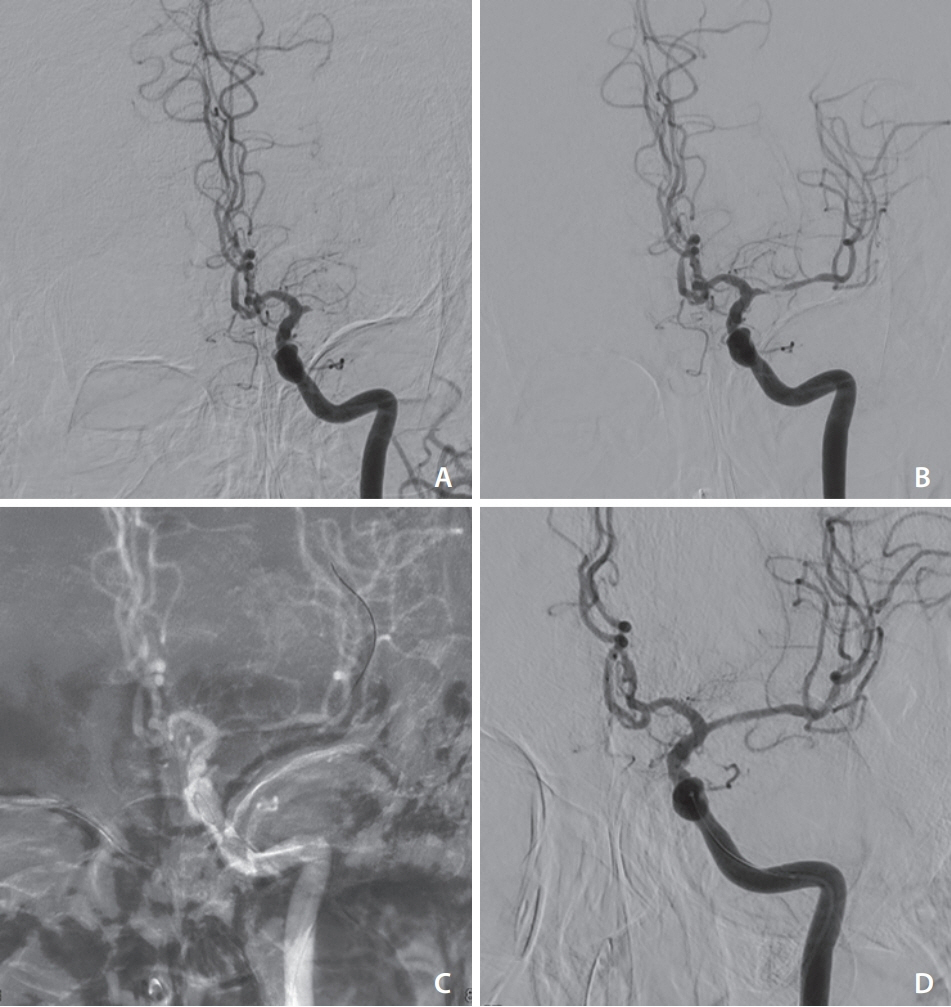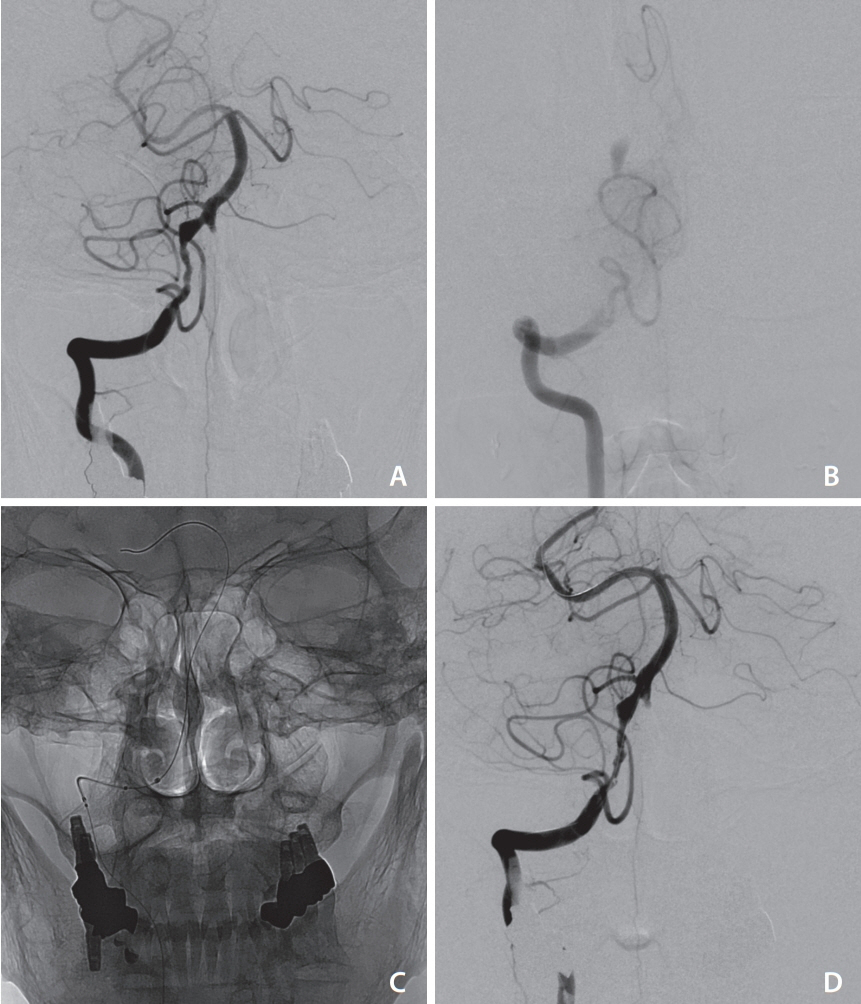Neurointervention.
2022 Mar;17(1):37-44. 10.5469/neuroint.2022.00017.
Usefulness of Self-Expandable Stent for Recanalization of Intracranial Atherosclerotic Disease: Preliminary Experience with Enterprise Stent
- Affiliations
-
- 1Department of Radiology, Ajou University School of Medicine, Suwon, Korea
- 2Department of Radiology, Kangwon National University Hospital, Kangwon National University School of Medicine, Chuncheon, Korea
- 3Department of Neurology, Gangnam Severance Hospital, Yonsei University College of Medicine, Seoul, Korea
- 4Department of Radiology, Gangnam Severance Hospital, Yonsei University College of Medicine, Seoul, Korea
- KMID: 2526624
- DOI: http://doi.org/10.5469/neuroint.2022.00017
Abstract
- Purpose
The purpose of this preliminary study is to evaluate the efficacy and safety of the Enterprise stent for intracranial atherosclerotic disease (ICAD) in patients who presented with acute stroke due to vessel steno-occlusion and in patients with symptomatic disease despite optimum medical management.
Materials and Methods
A retrospective data analysis was performed on 15 consecutive patients who were treated with Enterprise stenting for recanalization of symptomatic intracranial steno-occlusive arteries due to underlying ICAD. Their clinical and radiological data were reviewed to evaluate procedural results, periprocedural and postprocedural complications, and clinical outcome.
Results
Enterprise stents were deployed as a rescue method in 15 patients for recanalization of steno-occlusion. All patients achieved final modified thrombolysis in cerebral infarction (mTICI) score improvement (53.3% with a mTICI score from 0 to 2b or 3, 46.7% with a mTICI score from 1 to 3). Two postprocedural complications (1 symptomatic intracranial hemorrhage and 1 severe brain edema, 13.3%) occurred among 15 patients. Among 12 patients with acute ischemic stroke (AIS), 6 patients (50%) had improvement in their National Institute of Health Stroke Scale of more than 4 at discharge. Seven patients (58.3%) had a good functional outcome with 3-month modified Rankin Score (mRS)≤2, and mortality occurred (mRS=6) in 2 patients (16.7%). None of the 10 AIS and 3 transient ischemic attack patients experienced further ischemic events attributable to the treated steno-occlusion during the follow-up period (ranged from 4 to 36 months, median 12 months).
Conclusion
This retrospective study suggests that Enterprise stenting can effectively and safely achieve recanalization in symptomatic steno-occlusive intracranial arteries.
Figure
Reference
-
1. Wong LK. Global burden of intracranial atherosclerosis. Int J Stroke. 2006; 1:158–159.
Article2. Arenillas JF. Intracranial atherosclerosis: current concepts. Stroke. 2011; 42(1 Suppl):S20–S23.3. Kasner SE. Natural history of symptomatic intracranial arterial stenosis. J Neuroimaging. 2009; 19 Suppl 1:20S–21S.
Article4. Thijs VN, Albers GW. Symptomatic intracranial atherosclerosis: outcome of patients who fail antithrombotic therapy. Neurology. 2000; 55:490–497.
Article5. Henkes H, Miloslavski E, Lowens S, Reinartz J, Liebig T, Kühne D. Treatment of intracranial atherosclerotic stenoses with balloon dilatation and self-expanding stent deployment (WingSpan). Neuroradiology. 2005; 47:222–228.
Article6. Lee TH, Kim DH, Lee BH, Kim HJ, Choi CH, Park KP, et al. Preliminary results of endovascular stent-assisted angioplasty for symptomatic middle cerebral artery stenosis. AJNR Am J Neuroradiol. 2005; 26:166–174.7. Weber W, Mayer TE, Henkes H, Kis B, Hamann GF, Schulte-Altedorneburg G, et al. Stent-angioplasty of intracranial vertebral and basilar artery stenoses in symptomatic patients. Eur J Radiol. 2005; 55:231–236.
Article8. Zaidat OO, Klucznik R, Alexander MJ, Chaloupka J, Lutsep H, Barnwell S, NIH Multi-center Wingspan Intracranial Stent Registry Study Group, et al. The NIH registry on use of the Wingspan stent for symptomatic 70-99% intracranial arterial stenosis. Neurology. 2008; 70:1518–1524.
Article9. Costalat V, Maldonado IL, Vendrell JF, Riquelme C, Machi P, Arteaga C, et al. Endovascular treatment of symptomatic intracranial stenosis with the Wingspan stent system and Gateway PTA balloon: a multicenter series of 60 patients with acute and midterm results. J Neurosurg. 2011; 115:686–693.
Article10. Jiang WJ, Yu W, Du B, Gao F, Cui LY. Outcome of patients with ≥70% symptomatic intracranial stenosis after Wingspan stenting. Stroke. 2011; 42:1971–1975.
Article11. Gandini R, Chiaravalloti A, Pampana E, Massari F, Morosetti D, Spano S, et al. Intracranial atheromatous disease treatment with the Wingspan stent system: evaluation of clinical, procedural outcome and restenosis rate in a single-center series of 21 consecutive patients with acute and mid-term results. Clin Neurol Neurosurg. 2013; 115:741–747.
Article12. Durst CR, Geraghty SR, Southerland AM, Starke RM, Rembold K, Malik S, et al. Stenting of symptomatic intracranial stenosis using balloon mounted coronary stents: a single center experience. J Neurointerv Surg. 2015; 7:245–249.
Article13. Fujimoto M, Shobayashi Y, Takemoto K, Tateshima S, Viñuela F. Structural analysis for Wingspan stent in a perforator model. Interv Neuroradiol. 2013; 19:271–275.
Article14. Zhao LB, Park S, Lee D, Lee DH, Suh DC. Mechanism of procedural failure related to wingspan. Neurointervention. 2012; 7:102–108.
Article15. Dumont TM, Natarajan SK, Eller JL, Mocco J, Kelly WH Jr, Snyder KV, et al. Primary stenting for acute ischemic stroke using the Enterprise vascular reconstruction device: early results. J Neurointerv Surg. 2014; 6:363–372.
Article16. Mocco J, Hanel RA, Sharma J, Hauck EF, Snyder KV, Natarajan SK, et al. Use of a vascular reconstruction device to salvage acute ischemic occlusions refractory to traditional endovascular recanalization methods. J Neurosurg. 2010; 112:557–562.
Article17. Zaidat OO, Yoo AJ, Khatri P, Tomsick TA, von Kummer R, Saver JL, Cerebral Angiographic Revascularization Grading (CARG) Collaborators; STIR Revascularization working group; STIR Thrombolysis in Cerebral Infarction (TICI) Task Force, et al. Recommendations on angiographic revascularization grading standards for acute ischemic stroke: a consensus statement. Stroke. 2013; 44:2650–2663.
Article18. Sacco RL, Kargman DE, Gu Q, Zamanillo MC. Race-ethnicity and determinants of intracranial atherosclerotic cerebral infarction. The Northern Manhattan stroke study. Stroke. 1995; 26:14–20.
Article19. Inzitari D, Hachinski VC, Taylor DW, Barnett HJ. Racial differences in the anterior circulation in cerebrovascular disease. How much can be explained by risk factors? Arch Neurol. 1990; 47:1080–1084.
Article20. Lee SJ, Cho SJ, Moon HS, Shon YM, Lee KH, Kim DI, et al. Combined extracranial and intracranial atherosclerosis in Korean patients. Arch Neurol. 2003; 60:1561–1564.
Article21. Suh DC, Lee SH, Kim KR, Park ST, Lim SM, Kim SJ, et al. Pattern of atherosclerotic carotid stenosis in Korean patients with stroke: different involvement of intracranial versus extracranial vessels. AJNR Am J Neuroradiol. 2003; 24:239–244.22. Park KY, Chung CS, Lee KH, Kim GM, Kim YB, Oh K. Prevalence and risk factors of intracranial atherosclerosis in an asymptomatic Korean population. J Clin Neurol. 2006; 2:29–33.
Article23. Chimowitz MI, Lynn MJ, Howlett-Smith H, Stern BJ, Hertzberg VS, Frankel MR, Warfarin-Aspirin Symptomatic Intracranial Disease Trial Investigators, et al. Comparison of warfarin and aspirin for symptomatic intracranial arterial stenosis. N Engl J Med. 2005; 352:1305–1316.
Article24. EC/IC Bypass Study Group. Failure of extracranial-intracranial arterial bypass to reduce the risk of ischemic stroke. Results of an international randomized trial. N Engl J Med. 1985; 313:1191–1200.25. Kim DJ. Intracranial stenting; the current landscape. Neurointervention. 2021; 16:2–5.
Article26. Chimowitz MI, Lynn MJ, Derdeyn CP, Turan TN, Fiorella D, Lane BF, SAMMPRIS Trial Investigators, et al. Stenting versus aggressive medical therapy for intracranial arterial stenosis. N Engl J Med. 2011; 365:993–1003. Erratum in: N Engl J Med 2012;367:93.27. Levy EI, Turk AS, Albuquerque FC, Niemann DB, Aagaard-Kienitz B, Pride L, et al. Wingspan in-stent restenosis and thrombosis: incidence, clinical presentation, and management. Neurosurgery. 2007; 61:644–650. discussion 650-651.28. Turk AS, Levy EI, Albuquerque FC, Pride GL Jr, Woo H, Welch BG, et al. Influence of patient age and stenosis location on wingspan in-stent restenosis. AJNR Am J Neuroradiol. 2008; 29:23–27.
Article29. Albuquerque FC, Levy EI, Turk AS, Niemann DB, Aagaard-Kienitz B, Pride GL Jr, et al. Angiographic patterns of Wingspan in-stent restenosis. Neurosurgery. 2008; 63:23–27. discussion 27-28.
Article30. Vajda Z, Schmid E, Güthe T, Klötzsch C, Lindner A, Niehaus L, et al. The modified Bose method for the endovascular treatment of intracranial atherosclerotic arterial stenoses using the Enterprise stent. Neurosurgery. 2012; 70:91–101. discussion 101.
Article31. Kim JK, Ahn JY, Lee BH, Chung YS, Chung SS, Kim OJ, et al. Elective stenting for symptomatic middle cerebral artery stenosis presenting as transient ischaemic deficits or stroke attacks: short term arteriographical and clinical outcome. J Neurol Neurosurg Psychiatry. 2004; 75:847–851.
Article32. Kang DH, Kim YW, Hwang YH, Park SP, Kim YS, Baik SK. Instant reocclusion following mechanical thrombectomy of in situ thromboocclusion and the role of low-dose intra-arterial tirofiban. Cerebrovasc Dis. 2014; 37:350–355.
Article
- Full Text Links
- Actions
-
Cited
- CITED
-
- Close
- Share
- Similar articles
-
- Two cases of self expandable stent implantation in patient with occlusive restenosis of brachiocephalic vein stent
- Refinement of a Thrombectomy Technique to Treat Acute Ischemic Stroke: Technical Note on Microcatheter Advance during Retrieving Self-Expandable Stent
- Bench-Top Comparison of Three Different Types of Stents Used for Treatment of Intracranial Atherosclerotic Stenosis
- A Self-expanding Nitinol Stent (Enterprise) for the Treatment of Wide-necked Intracranial Aneurysms: Angiographic and Clinical Results in 40 Aneurysms
- Bench-top Comparison of Physical Properties of 4 Commercially-Available Self-Expanding Intracranial Stents



